Moniek Bloks's Blog, page 66
November 16, 2023
Aleida of Culemborg, Bertha of Heukelom and Maria of Avenes – Ladies of IJsselstein
The Lordship of IJsselstein was part of the Holy Roman Empire and now lies in the Netherlands. It began in the 13th century and ended with the founding of the Batavian Republic in 1795. By then, the title had been with the House of Orange-Nassau since the 16th century, and they now rule the Kingdom of the Netherlands. Officially, King Willem-Alexander still holds the title of Lord of IJsselstein.
The Reformed Church in IJsselstein still holds two magnificent tombs with the remains of several Lords and Ladies of IJsselstein. There is one single tomb for Aleida of Culemborg and a shared tomb with Gijsbrecht of Amstel, his wife Bertha of Heukelom, their son Arnold and his wife Maria of Avesnes.
Aleida of Culemborg
Aleida of Culemborg was born circa 1445 as the daughter of Gerard of Culemborg and Elizabeth of Buren.
She had a brother named Jasper, who succeeded their father as Lord of Culemborg. In her own right, Aleida became Lady of Sint-Maartensdijk and Buren in the Netherlands. In 1464, she married Frederik of Egmont, who was the Lord of IJsselstein. They went on to have two children together, including their heir, Floris of Egmont. Aleida was still only around 26 years old when she died on 20 July 1471. Her cause of death is not clear.
Through her son Floris, she was the great-grandmother of Anna of Buren, who married William I, Prince of Orange.
Aleida’s magnificent tomb in IJsselstein still survives to this day despite a devasting fire in 1911. The tomb was completely restored and painted white. It originally had several different colours. The tomb is made of sandstone, and she is shown with two angels supporting the pillow her head rests on, and a little dog is sleeping at her feet.
Click to view slideshow.Bertha of Heukelom
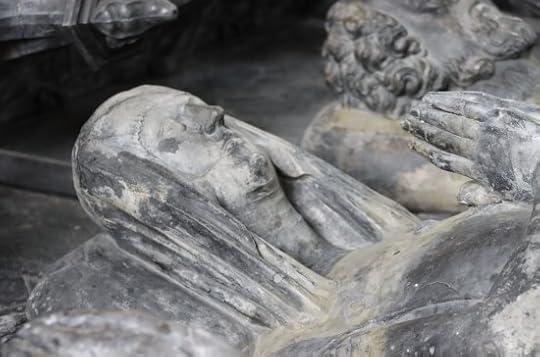 Photo by Moniek Bloks
Photo by Moniek BloksBertha was born on an unknown date as the daughter of Otto I of Arkel, Lord of Heukelom and a woman who had the last name Van Heusden. Around 1280, Bertha married Gijsbrecht of Amstel, who was later known as Gijsbrecht of IJsselstein, as he became the first Lord of IJsselstein. They went on to have five sons and two daughters.
Bertha has gone down in history as a heroine for defending the Castle of IJsselstein during the power struggle between the Bishops of Utrecht and John I, Count of Holland, following the murder of John’s father, Floris V, Count of Holland. John claimed the castle, but Gijsbrecht refused to give it up, and he was taken prisoner. The castle then came under siege by the Lord of Culemborg with Bertha at its defence. It was later said that “Lady Bertha was so bold that she wouldn’t give up her house for anything; not for the sake of friends, nor for relatives.”1 After several weeks, Bertha made a deal, which meant she had to give up the castle, but she managed to trick the Lord of Culemborg into only taking a few men prisoner. After this, John gave the castle to Catharina of Durbuy before it passed to a relative, Guy of Avesnes. His daughter Maria married Bertha’s son, Arnold, bringing the castle back to the family. Bertha died on 25 February 1322.
Maria of Avesnes
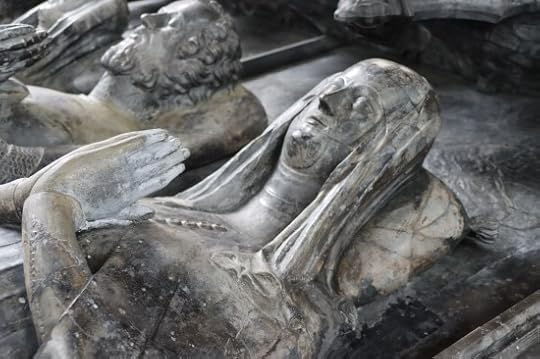 Photo by Moniek Bloks
Photo by Moniek BloksMaria was born on an unknown as the daughter of Guy of Avesnes, who was the Bishop of Utrecht from 1301 to 1317, and an unknown woman. She had a sister named Aleid, and it’s unclear if they were born from a marriage before Guy entered the religious life or if they were illegitimate. Maria married Arnold, Lord of IJsselstein, in 1410. The couple went on to have four daughters together: Guyote, Catharina, Bertha and Beatrice. Maria died around 1346/1347. Guyote married John I, Lord of Egmond and had six sons and seven daughters.2 She succeeded her father as Lady of IJsselstein.
Click to view slideshow.Guyote was most likely the one who ordered the tomb of her parents and grandparents. It is likely that she and her husband are also buried, but they are not depicted on it.3
The Reformed Church in IJsselstein is open to visitors but only on Saturday afternoons.
The post Aleida of Culemborg, Bertha of Heukelom and Maria of Avenes – Ladies of IJsselstein appeared first on History of Royal Women.
November 14, 2023
The Royal Art Exhibition
The Royal Art Exhibition from the Museum Gouda explores the close connection between the Dutch royal house and the art world and offers a glimpse at some items that are not often on display.
The exhibition starts with the grand wedding portrait of Queen Wilhelmina and Prince Henry, and the room also includes several wedding presents.
Click to view slideshow.The second room is wholly dedicated to a so-called art cabinet, which they also received as a wedding present. The cabinet contains over 100 pieces of art, which are all projected onto the wall opposite.
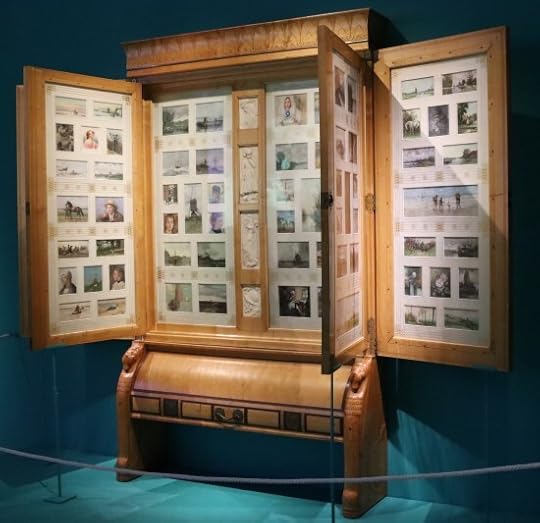 Photo by Moniek Bloks
Photo by Moniek BloksThe last two rooms are dedicated to art made by Queen Wilhelmina herself and also to art she received as a gift or art that was exchanged in the family. The most touching artworks are that of Queen Wilhelmina’s pony Baby, which she received as a personal gift from the painter, and a gift from her mother with a personal inscription.
Click to view slideshow.While the exhibition is small in size, it is grand in its experience. The works are absolutely lovely to look at, and I particularly enjoyed the personal pieces and the art done by Queen Wilhelmina herself, such as the violets.
Royal Art at Museum Gouda will run until 5 May 2024. Plan your visit here.
The post The Royal Art Exhibition appeared first on History of Royal Women.
November 13, 2023
Royal Wedding Recollections – Princess Anne & Mark Phillips
On 29 May 1973, the engagement of Princess Anne and Mark Phillips was announced. She was not created Princess Royal until 1987, and as a child of the monarch, she was known as “The Princess Anne.”
The New York Times reported, “They met at the horse events at the Olympics in Mexico. They competed in jumping trials all over England. Their romance became the talk of the land. And tonight Buckingham Palace announced the engagement of the two young riders: Princess Anne and Lieutenant Mark Phillips.”1
Embed from Getty ImagesThey were married at Westminster Abbey on 14 November 1973, her brother’s 25th birthday. The service was conducted by Michael Ramsey, the Archbishop of Canterbury.
Embed from Getty ImagesPrincess Anne wore a Tudor-style wedding dress with embroidery and a high collar. The dress was designed by Maureen Baker, who was the chief designer for Susan Small. The New York Times described it as “princess line, with Elizabethan sleeves over finely pleated white silk chiffon undersleeves, which were edged with pearls and mirror jewels. The transparent shoulder train was of silk net, embroidered with floral sprays of silk and silver thread.”2 She wore the Queen Mary Fringe Tiara to secure her veil. Mark Phillips wore the dress uniform of the Queen’s Dragoon Guards.
The BBC broadcasted the ceremony, and millions watched from all over the world.
Embed from Getty ImagesMark Phillips revealed in their pre-wedding interview that he had not been offered a peerage and that he would not have accepted one if he had been offered one. Thus, Princess Anne was styled as “The Princess Anne, Mrs. Mark Phillips” until she was created Princess Royal in 1987.
They went on to have two children together, Peter (born 1977) and Zara (born 1981), before divorcing in 1992. Anne remarried in December 1992 to Timothy Laurence.
The post Royal Wedding Recollections – Princess Anne & Mark Phillips appeared first on History of Royal Women.
November 12, 2023
Princess Francisca Moctezuma – The forgotten daughter of Emperor Moctezuma II
Princess Francisca Moctezuma is the least known of Emperor Moctezuma II’s recorded daughters. Unlike her half-sisters, Empress Isabel Moctezuma and Princess Mariana Leonor Moctezuma, Princess Francisca was not awarded with any towns by the Spanish conquistadors. According to historian Camilla Townsend, this is most likely because she rarely interacted with the Spanish conquistadors.[1] Despite not having an inheritance, Princess Francisca Moctezuma managed to become one of the most prominent women in Mexico. She was the wife of the first governor of Tenochtitlan.
Princess Francisca Moctezuma was born in 1519 in Tenochtitlan during the Spanish invasion of the Aztec Empire.[2] Her original name remains unrecorded. Francisca was her baptised and christened name when she converted to Catholicism after the fall of the Aztec Empire.[3] She was the youngest of Emperor Moctezuma II’s daughters.[4] Her mother was Queen Tlapalizquixochtzin (the queen regnant of the Aztec city-state of Ecatepec and the second Empress of Emperor Moctezuma II).[5] She had numerous half-siblings, many of whom are still unknown.[6] Among her known half-siblings are Isabel Moctezuma (the last Aztec Empress), Pedro Moctezuma, and Mariana Leonor Moctezuma.
On 30 June 1520, Emperor Moctezuma II died of mysterious circumstances. Queen Tlapalizquixochtzin perished shortly afterwards, on 1 July 1520, while trying to escape Tenochtitlan during the Night of Sorrows. The deaths of her parents left Princess Francisca Moctezuma an orphan.[7] She was left in the care of her older half-sister, Isabel Moctezuma, who became the Empress of two Aztec Emperors, Cuitlahuac and Cuauhtémoc.[8] After the death of the last Aztec Emperor in 1525, Princess Francisca was sent to Ecatepec to be raised by her maternal aunt named Princess Tlacuilolxotzin and uncle named Tecocomoctli Aculnahuacatzintli.[9] They had two sons named Don Diego de Alvarado Huanitzin (the former King of Ecatepec) and Francisco Matlaccoatzin, who went to Spain.[10] Therefore, Princess Francisca Moctezuma did not interact with the Spanish conquistadors.[11] This is why the Spanish did not award her with any towns.[12]
Princess Francisca Moctezuma eventually married her first cousin, Don Diego de Alvarado Huanitzin.[13] He became the first governor of Tenochtitlan from 1538 until his death in 1541.[14] They had many children.[15] Among them are Juana de Alvarado, Cristóbal de Guzmán Cecetzin (who later became the third governor of Tenochtitlan), and Isabel (who later married Antonio Valeriano). Yet, the most famous of Princess Francisca Moctezuma’s children was Hernando Alvarado Tezozomoc, the historian who wrote the chronicle Cronica Mexicayotl.[16] There is no record of how and when Princess Francisca Moctezuma died.
Princess Francisca Moctezuma remains the least known of Emperor Moctezuma II’s recorded daughters because of her less frequent interactions with the Spanish. The Spanish conquistadors did not give her an inheritance like her other half-sisters. Despite not being an heiress, Princess Francisca Moctezuma became one of the most respected and prominent women in Mexico. She was the wife of a former king and the first governor of Tenochtitlan. Some of her children would also become prominent members of Mexican history. After the fall of the Aztec Empire, Princess Francisca Moctezuma managed to have a successful life under the Spanish regime.
Sources:
Chimalpahin Cuauhtlehuanitzin, D. F. D. S. A. M., Chimalpahin, D. D., & Ruwet, W. (1997). Codex Chimalpahin: Society and politics in Mexico Tenochtitlan, Tlateloloco, Texcoco, Culhuacan, and other Nahua Altepetl in Central Mexico : the Nahuatl and Spanish annals and accounts. (A. J. O. Anderson, Ed. & Trans.; S. Schroeder, Ed. & Trans.). United Kingdom: University of Oklahoma Press.
Chipman, D. E. (2010). Moctezuma’s Children: Aztec Royalty Under Spanish Rule, 1520–1700. (n.p.): University of Texas Press.
Kalyuta, A. (January 30, 2010). “Doña Isabel de Moctezuma: the emperor’s favourite daughter?”. Aztecs at Mexicolore. Retrieved on 30 January 2023 from https://www.mexicolore.co.uk/aztecs/m....
Myers, K. A. (2015). In the Shadow of Cortés: Conversations Along the Route of Conquest. Tucson, Arizona: University of Arizona Press.
Townsend, C. (2019). Fifth Sun: A New History of the Aztecs. United States: Oxford University Press.
[1] Townsend, 2019
[2] Kalyuta, 30 January 2010, “Doña Isabel de Moctezuma: the emperor’s favourite daughter?”
[3] Townsend, 2019
[4] Kalyuta, 30 January 2010, “Doña Isabel de Moctezuma: the emperor’s favourite daughter?”
[5] Chimalpahin Cuauhtlehuanitzin, et al., 1997
[6] Chipman, 2005
[7] Townsend, 2019
[8] Kalyuta, 30 January 2010, “Doña Isabel de Moctezuma: the emperor’s favourite daughter?”
[9] Townsend, 2019
[10] Chimalpahin Cuauhtlehuanitzin, et al., 1997
[11] Townsend, 2019
[12] Townsend, 2019
[13] Townsend, 2019
[14] Townsend, 2019
[15] Kalyuta, 30 January 2010, “Doña Isabel de Moctezuma: the emperor’s favourite daughter?”
[16] Myers, 2015
The post Princess Francisca Moctezuma – The forgotten daughter of Emperor Moctezuma II appeared first on History of Royal Women.
November 11, 2023
Book News Week 46
Book News Week 46 – 13 November – 19 November 2023

Uncrowned: Royal Heirs Who Didn’t Take the Throne
Hardcover – 15 November 2023 (UK)

Pomp and Piety: Everyday Life of the Aristocracy in Stuart England
Hardcover – 15 November 2023 (UK)

Mortal Monarchs: 1000 Years of Royal Deaths
Paperback – 14 November 2023 (US)
The post Book News Week 46 appeared first on History of Royal Women.
November 10, 2023
The Royals & Rebels: British Fashion Exhibition
The Kunstmuseum in The Hague is hosting a new exhibition called “Royals & Rebels: British Fashion.”
Following Queen Elizabeth II’s death, King Charles III’s coronation, hit shows such as The Crown and Queen Charlotte, and the deaths of designers Vivienne Westwood and Mary Quant, the interest in British fashion has been reawakened. The fascination with British fashion goes back quite a bit and inspired carriages, garden designs and clothes.
The exhibition takes the visitors through several worlds of fashion, such as “In the City” and “In the Country.” While the spotlight is on British fashion, its common thread is Vivienne Westwood.
Some of the royal items included in the exhibition are a dress and suit worn by Diana, Princess of Wales, hats worn by Queen Máxima during an official visit to the United Kingdom and the coronation of King Charles III, a reproduction of one Diana, Princess of Wales’s famous sheep sweater. There is also an outfit based on Queen Elizabeth I.
Click to view slideshow.Among the other items is the famous Carrie Bradshaw wedding dress.
Click to view slideshow.I will be the first to admit that I am not that into fashion personally, but I loved this exhibition. I loved how everyone seemed to be bonding over memories regarding the more recognisable pieces. The rooms are bright and spacious, and you’re still able to get up close. The royal pieces were great to see, and they drew plenty of attention. If I had to name one thing I didn’t like, it was the incorrect use of titles.
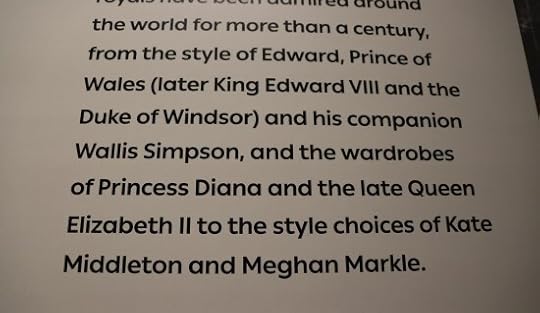 Photo by Moniek Bloks
Photo by Moniek BloksThe Princess of Wales and the Duchess of Sussex are named “Kate Middleton” and “Meghan Markle”, Diana, Princess of Wales is “Princess Diana” and the Duchess of Windsor is “Wallis Simpson” and she is listed as the Duke’s companion rather than his wife. Now, I know these are often used for SEO reasons, but this is an information sign and, thus, should be correct.
Do go and see this exhibition; you can find the visitor information here. The exhibition will run until 7 January 2024.
The post The Royals & Rebels: British Fashion Exhibition appeared first on History of Royal Women.
November 9, 2023
Royal Jewels – Queen Mary’s Town of Windsor Ring
One of the little-known gems of the British royal family’s jewellery collection is Queen Mary’s Town of Windsor Ring.
It was a wedding present for the future Queen Mary from the town of Windsor in 1893. It was reset for her in 1924. It was bequeathed to Queen Elizabeth the Queen Mother in 1953 and passed to Queen Elizabeth II in 2002.
It is a “three-stone ring, the brilliant in openwork claw settings, with plain hoop.”1
The post Royal Jewels – Queen Mary’s Town of Windsor Ring appeared first on History of Royal Women.
November 7, 2023
Maria Josepha of Saxony – “A great and dignified Princess” (Part three)
In correspondence with her brother Xavier, Maria Josepha spoke often about the loss of her eldest son. She even asked his forgiveness for only talking about him, “who occupies her mind and her heart.”1 The Duke of Berry now became next in the line of succession after his father.
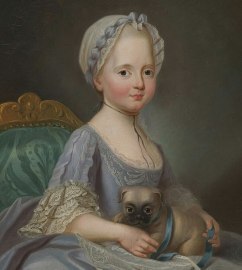 Elisabeth (public domain)
Elisabeth (public domain)In 1763, Maria Josepha became pregnant for the last time, and the death of her father on 5 October 1763 hit her hard. The following April, she wrote, “I am tired as a dog, I am not accustomed to finding myself so advanced in pregnancy in Holy Week.”2 On 3 May 1764, at 2 in the morning, Maria Josepha gave birth to a daughter, who received the name Elisabeth. Tragically, neither parent would get to see Elisabeth grow up.
In early August 1765, the Dauphin went to watch a military manoeuvre in a wet meadow, and he hurried home without changing into dry clothes. He ended up with a bad cold, and a fever developed. Maria Josepha once again became his devoted nurse. He appeared to be better, but a cough persisted. On 20 October, she wrote to her brother, “Your poor sister is dying of worry.”3 The Dauphin soon began to cough up blood, and his condition deteriorated. By early December, a tumour had formed, which caused him considerable pain, and he could no longer lie flat on his back. By the 13th, he was in excruciating pain, and he sent Maria Josepha away as she was exhausted. She was with her sister-in-law Adélaïde when she was informed that her husband had died on 20 December 1765. Maria Josepha promptly fainted when told, “Madame, bless the Lord, we have another saint in the sky.”4
A few days later, she wrote to her brother, “The good Lord wanted me to survive the one for whom I would have given a thousand lives.”5 In her grief, she ordered her ladies to cut her hair off. Her first wedding anniversary without her husband was a painful one. She wrote, “Nineteen years ago, I was united to the one I no longer have. Happiness passes quickly.”6 The King offered her a new apartment to escape the painful memories, which she gladly accepted. He visited her often and tried to console her as best he could. However, it soon became apparent that Maria Josepha also had a persistent cough. She did not care for her health and felt like she had nothing left to live for anymore except her children, who brought her joy.
When told of a possible match between her eldest son and Archduchess Marie Antoinette, she said, “The best way to ensure Vienna’s good graces would be to keep her between fear and hope.”7 The King promptly put an end to the negotiations. By April, she, too, was coughing up blood, but she continued to instruct her children, including her “treasure”, the new Dauphin.8
By September 1766, she claimed to feel better, but in early 1767, she wrote, “It’s going from bad to worse.”9 The King called another doctor to treat her. In February, one observer wrote, “She is pale enough to make your heart bleed.”10 She was also quickly losing weight, and her brother sent her wine from Hungary.
By March, it was clear that she wasn’t going to survive. On 9 March, she asked her children to come to her, but she no longer had the strength to talk to them. She entrusted her children to her sister-in-law, Adélaïde and her mother-in-law, Queen Marie. On 13 March, she heard Mass in her room and was told, “Rejoice, Madame, you are going, in exchange for a life spent in sadness and tears, to begin an eternally happy reign.”11 She asked for a crucifix and kissed it several times. Then, “her shining eyes open wide without seeming to see or look at anyone.”12 She died on 13 March 1767 at the age of just 35.
She had asked for a simple funeral, but the King ordered a grand affair. She was interred next to her husband, and during the French Revolution, their remains were saved by being moved to a cemetery. They were returned to the Cathedral of Sens in 1814.
The post Maria Josepha of Saxony – “A great and dignified Princess” (Part three) appeared first on History of Royal Women.
November 5, 2023
Maria Josepha of Saxony – “A great and dignified Princess” (Part two)
Maria Josepha’s main goal was now to provide an heir to the throne. In January 1749, her “hopes were dashed,” and it was feared that she would not be able to carry a pregnancy to term. Queen Marie spent the evening with Maria Josepha to cheer her up.1 There was another false alarm in April, and the King summoned several doctors who recommended the waters of Forges. She left at the end of June and spent a whole month taking the waters.
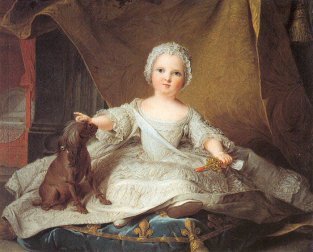 Marie Zéphyrine (public domain)
Marie Zéphyrine (public domain)Maria Josepha was soon pregnant again, and every precaution was taken. The Queen’s concerts took place in the Dauphine’s room to spare her fatigue, and she was bled, according to the treatment plan. The pregnancy progressed as usual, and on 26 August 1750, Maria Josepha went into labour. At six in the afternoon, she gave birth to a daughter – much to the court’s disappointment. One courtier wrote, “The birth of a princess threw the court into a state of consternation similar to that caused by a lost battle that brought the enemy to the gates of Paris…”2 The celebrations for the birth of a Duke of Burgundy were cancelled, and the princess was named Marie Zéphyrine. Maria Josepha wrote, “She is very small and even more delicate. She is very ugly; it is said that she resembles me like two drops of water, very willful and mean like a little dragon.”3 Nevertheless, the Dauphin acted quite thoughtfully towards his disappointed wife.
She fell pregnant again relatively quickly, and by 13 June 1751, it was noted that she “walks so lightly that one does not notice that she is so far along in her pregnancy.”4 On 13 September, she gave birth to a son, much to the joy of her husband. The King examined the newborn and proclaimed him “strong and healthy.”5 He also presented Maria Josepha with an aigrette with diamonds and rubies, telling her that “the gift you have just given to France is infinitely more precious.”6
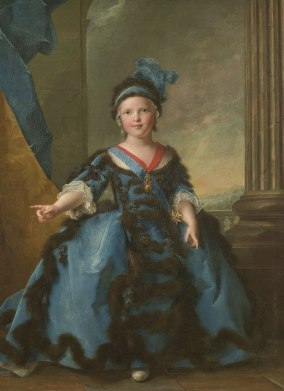 The Duke of Burgundy (public domain)
The Duke of Burgundy (public domain)The following year, Maria Josepha was deeply saddened by the death of her sister-in-law Henriette, who died at the age of 24 after a short illness. Maria Josepha, who was again pregnant, was not immediately told in case the shock would cause her to miscarry. She was only told when etiquette demanded that the family leave the palace. Nevertheless, the pregnancy wasn’t carried to term. Then, her husband fell ill with smallpox, and Maria Josepha immediately took up his care on her own, which earned her admiration all around. He survived his illness.
Maria Josepha quickly fell pregnant again, and on 8 September 1753, she gave birth to a Duke of Aquitaine, who was named for her brother Xavier. Tragically, he would die of whooping cough on 22 February 1754. Just a few months later, Maria Josepha gave birth to a third son, the future King Louis XVI. He was given the title Duke of Berry. Then tragedy struck again when Marie Zéphyrine died suddenly on 2 September 1755. She had woken up screaming in pain and suffered two days of convulsions before succumbing. She had just turned five years old.
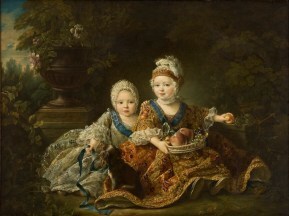 The Duke of Berry (right) with his younger brother, the Count of Provence (public domain)
The Duke of Berry (right) with his younger brother, the Count of Provence (public domain)Maria Josepha was already six months into another pregnancy, and on 17 November 1755, she gave birth to a son who was “sickly, thin and not very viable.”7 Nevertheless, the boy lived and received the title Count of Provence. Yet another son was born on 9 October 1757, he was “small but well made and likely to live.”8 He received the title Count of Artois. Maria Josepha was deeply distressed during this time because of the invasion of Saxony, and she suffered from palpitations. When news reached her that her mother had died in November, she wrote, “What a loss for us and for the whole country. […] She has received the reward for her virtues, she is forever happy. We are the only ones to be pitied. Let us strive to follow in her footsteps, to imitate her virtues, in order to one day share this happiness. If she loved us in this world, she loves us a hundred times more at this hour…”9
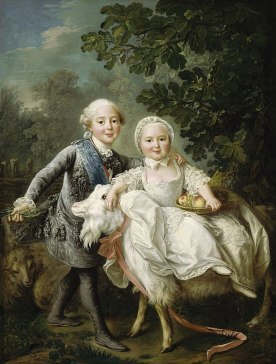 The Count of Artois and Marie Clotilde (public domain)
The Count of Artois and Marie Clotilde (public domain)Another child followed on 23 September 1759, this time, it was a girl, who was named Marie Clotilde. She apparently arrived so quickly that only her father, a nursemaid and the midwife were present in the room. By the end of 1759, the health of their eldest son, the Duke of Burgundy, had become a concern. He had suffered a fall that caused quite a bit of damage to his leg. He was “in a very bad condition.[…] There is talk of cutting off his leg.”10 Eventually, a tumour formed on the leg, and doctors decided to operate. Maria Josepha was horrified and wrote, “It’s tomorrow that we have to pierce my son’s tumour… the state I am in.”11
The little boy underwent the operation while he was awake, although he received a mixture of honey and opium. The pus was drained from the tumour as he clenched his teeth, and the operation was declared a success. Maria Josepha wrote, “The operation was most successful and the tranquillity that my son has enjoyed since gives a lot of hope for the future.[…] I am still beside myself from the passage to the greatest anxiety to the greatest joy.”12 Unfortunately, her joy did not last long. The boy became weaker, and the wound became very painful. Maria Josepha went on a pilgrimage to Notre Dame to pray for her son’s health, but it was no use. For months, the boy suffered, and by the end of the year, it was believed that he would not recover.
He continued to live while moaning, “I can’t take it anymore.”13 On 7 March 1761, Maria Josepha wrote, “Everything tells me that my misfortune is not far away.”14 On 16 March, he received Last Rites. On the 21st, around two at night, he asked for a crucifix. He cried out for his mother and died without her by his side. Maria Josepha and the Dauphin were not informed until 8 in the morning. They were devastated, and the following day, Maria Josepha wrote, “My son is in heaven.”15
Part three coming soon.
The post Maria Josepha of Saxony – “A great and dignified Princess” (Part two) appeared first on History of Royal Women.
November 4, 2023
Book News Week 45
Book news week 45: 6 November – 12 November 2023
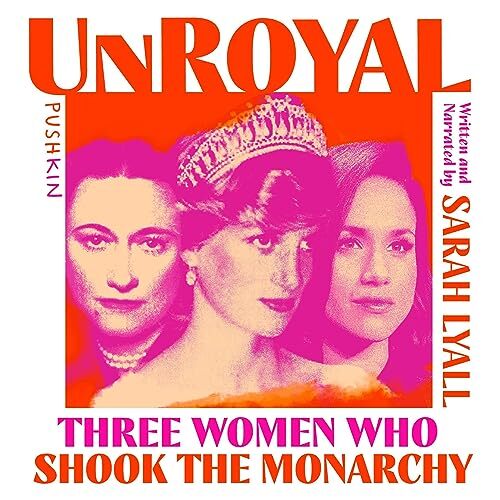
Unroyal: Three Women Who Shook the Monarchy
Audiobook – 7 November 2023 (US & UK)
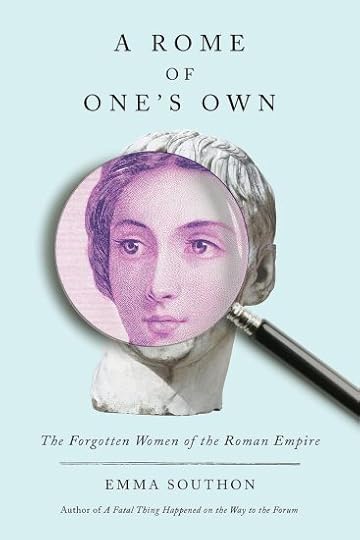
A Rome of One’s Own: The Forgotten Women of the Roman Empire
Hardcover – 7 November 2023 (UK & US)
The post Book News Week 45 appeared first on History of Royal Women.



